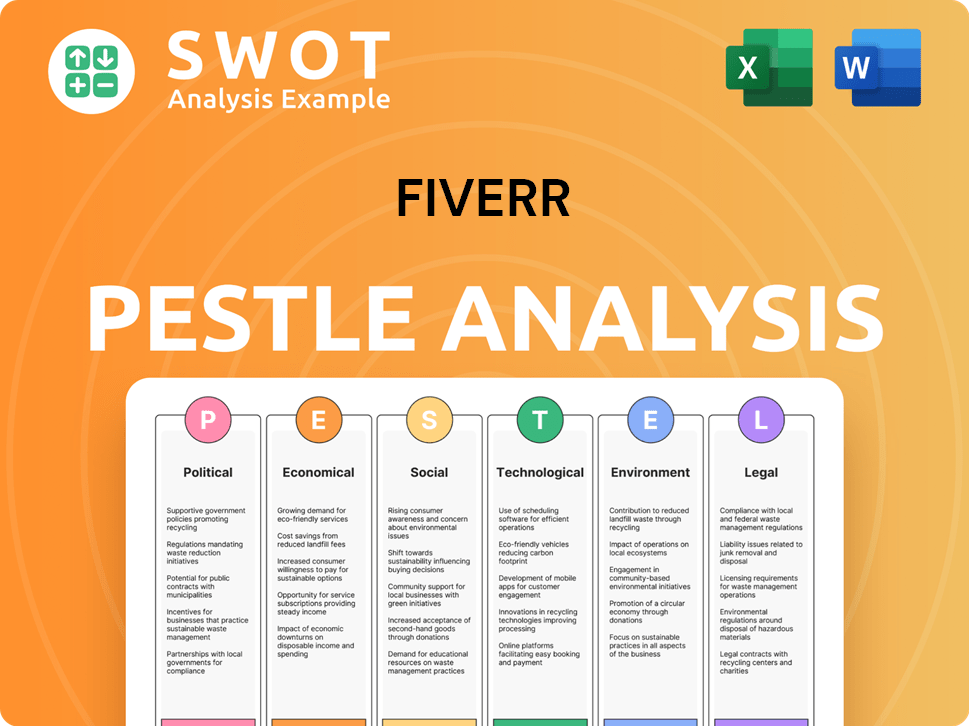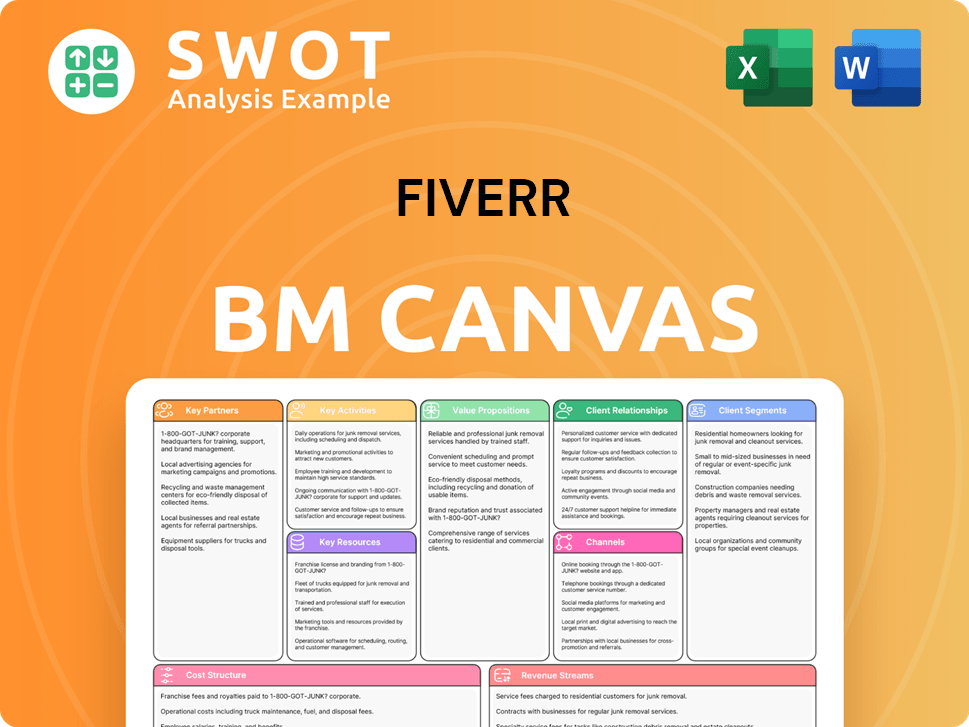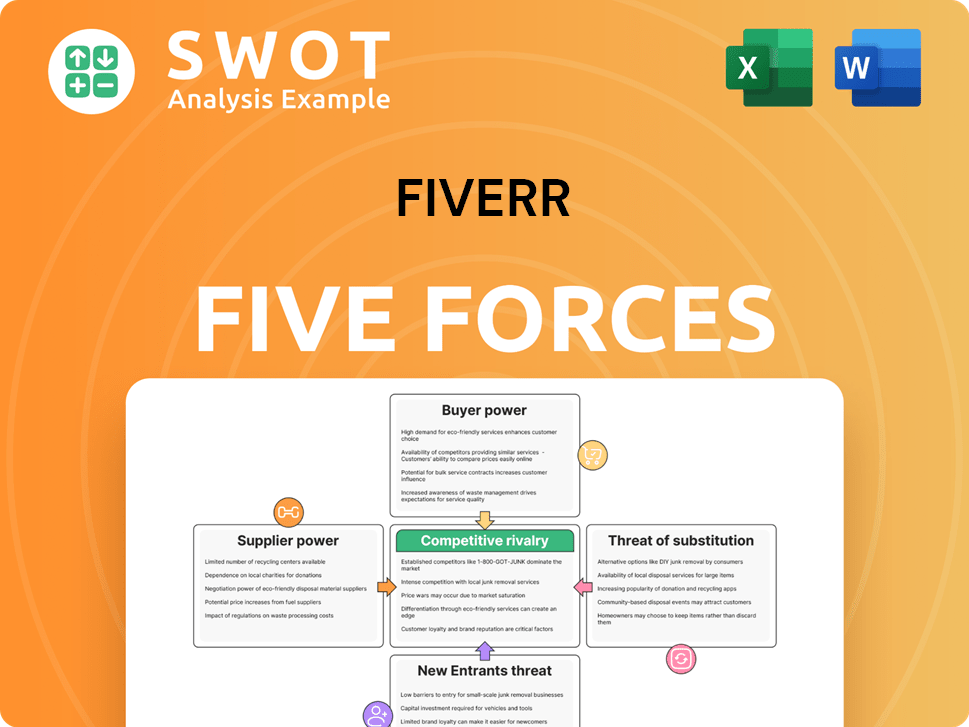Fiverr Bundle
How Does Fiverr Dominate the Freelance Marketplace?
Fiverr revolutionized the gig economy with its simple premise: buy and sell digital services starting at just $5. Launched in 2010, this innovative online services platform quickly gained traction, transforming how businesses and freelancers connect. But how has Fiverr sustained its growth and market leadership?

This analysis dives into the Fiverr SWOT Analysis to uncover its sales and marketing strategy. We'll explore Fiverr's business model, including its approach to acquiring customers and retaining them, examining its primary sales channels and marketing tactics. Understanding Fiverr's approach provides valuable insights for anyone navigating the freelance marketplace or seeking to build a successful online business.
How Does Fiverr Reach Its Customers?
The core of the sales strategy for the online services platform centers around its proprietary e-commerce platform, Fiverr.com, which directly connects freelancers with clients. This direct-to-consumer (DTC) approach, amplified by its mobile applications, has been fundamental to its operations since its inception. The company has evolved its pricing structure, moving beyond the initial $5 gig model to accommodate a wide range of service prices.
Fiverr's marketing strategy emphasizes digital adoption and omnichannel integration to ensure a seamless user experience across its web and mobile platforms. A key component of this strategy is the "going upmarket" approach, focusing on complex services and enterprise-level solutions through 'Fiverr Business Solutions'. The freelance marketplace model also leverages its vast network of freelancers as a distributed sales force, offering services across numerous categories.
The company's focus on increasing 'wallet share' by encouraging cross-category purchasing and improving buyer-seller matching also contributes to growth within its existing channels. The platform's success is intrinsically linked to the success of its buyers and sellers, creating a symbiotic relationship that drives platform usage and revenue.
The primary sales channel for the company is its proprietary e-commerce platform, Fiverr.com. This platform serves as a direct link between freelancers and clients. The website and mobile apps (iOS and Android) are central to the business model.
Mobile apps, released in 2013 and 2014, are a key part of the sales strategy, ensuring accessibility. These apps support the platform's DTC model, allowing users to access services on the go. The mobile apps are a significant part of the omnichannel approach.
Fiverr is increasingly targeting larger companies with its 'Fiverr Business Solutions'. This shift marks a move beyond individual transactions to cater to enterprise-level needs. This expansion allows the company to offer tailored tools and talent to larger clients.
The freelance marketplace model relies on the success of both buyers and sellers. The company encourages cross-category purchasing to increase 'wallet share'. The platform's take rate for the period ended December 31, 2024, was 27.6%, an increase from 27.4% in the prior year.
Fiverr's performance metrics reveal insights into its sales strategy. The company reported 3.6 million annual active buyers as of December 31, 2024. Despite a 10% year-over-year decline from 4.0 million in 2023, the annual spend per buyer increased.
- Annual spend per buyer increased by 9% year-over-year, reaching $302 as of December 31, 2024, up from $278 in 2023.
- The marketplace 'take rate' for the period ended December 31, 2024, was 27.6%, an increase from 27.4% in the prior year.
- The company's Brief History of Fiverr shows how the platform has evolved.
- The platform's focus on higher-value transactions and enterprise solutions is evident in these figures.
Fiverr SWOT Analysis
- Complete SWOT Breakdown
- Fully Customizable
- Editable in Excel & Word
- Professional Formatting
- Investor-Ready Format

What Marketing Tactics Does Fiverr Use?
The marketing tactics of a leading online services platform are heavily geared towards digital strategies, aiming to enhance brand visibility, generate leads, and boost sales. The approach is multifaceted, incorporating various digital marketing techniques to reach a broad audience and engage both freelancers and clients. A core element of their strategy involves leveraging content marketing, SEO, and paid advertising to drive traffic and conversions.
The platform's marketing strategy is data-driven, emphasizing customer segmentation and personalization to deliver relevant marketing messages. This approach aims to improve customer retention and optimize marketing spend. The company continuously invests in AI and technology to improve user experience and drive long-term growth. This includes enhancing UI/UX through intuitive dashboards and metrics, and integrating AI capabilities across search and order experiences.
The freelance marketplace focuses on a customer-centric approach, using data analytics to inform decision-making. The company also focuses on improving its Lifetime Value to Customer Acquisition Cost (LTV/CAC) ratio, indicating efficient marketing spend. This comprehensive approach allows the platform to maintain a competitive edge in the gig economy.
Content marketing is a key component, with a focus on creating high-quality, relevant content. This includes blogs and videos that highlight services and differentiate freelancers.
SEO is crucial for visibility. Freelancers are encouraged to optimize gig titles, descriptions, URLs, and tags with relevant keywords. This helps them appear prominently in search results.
Paid advertising, including Google Ads, is utilized to promote gigs and acquire customers. This helps to reach a wider audience and drive traffic to the platform.
Email marketing is a key component. The platform frequently publishes industry research reports and information on new gig categories through newsletters.
Influencer partnerships are part of the strategy, particularly for video content, to boost brand visibility and credibility. This helps to reach a broader audience.
Social media platforms are essential for promotion and engagement. The platform maintains a presence on platforms like X, Instagram, and Facebook.
The platform leverages 'Fiverr Analytics' for freelancers to make informed decisions about their gig offerings and pricing strategies. Customer segmentation and personalization are also key. AI-driven personalization is a significant trend, aiming to deliver more relevant marketing messages and improve customer retention. The company's marketing efficiency is highlighted by its improving Lifetime Value to Customer Acquisition Cost (LTV/CAC) ratio, which reached over 2.1x for the Q2 2023 cohort, indicating efficient marketing spend. The company continues to invest in AI to drive long-term growth and enhance user experience, with deeper integration of 'Fiverr Neo' across search and order experiences. For those interested in the company's overall strategy, further insights can be found in the Growth Strategy of Fiverr.
- Fiverr sales strategy includes a strong emphasis on data analytics and AI.
- Fiverr marketing strategy focuses on content marketing, SEO, and paid advertising.
- The Fiverr business model benefits from efficient marketing spend, as indicated by the LTV/CAC ratio.
- The platform's approach to customer acquisition and retention is highly data-driven.
Fiverr PESTLE Analysis
- Covers All 6 PESTLE Categories
- No Research Needed – Save Hours of Work
- Built by Experts, Trusted by Consultants
- Instant Download, Ready to Use
- 100% Editable, Fully Customizable

How Is Fiverr Positioned in the Market?
Fiverr's brand positioning centers on democratizing access to talent and opportunities within the freelance marketplace, aiming to reshape how the world works. The platform differentiates itself by providing an easy-to-use space where businesses and individuals can find and hire freelancers for a wide array of digital services. This approach is a core component of its Fiverr sales strategy.
The brand's core message emphasizes affordability, convenience, and a diverse talent pool, starting with the 'gigs' concept, which began at $5. Even though the pricing model has changed, this initial perception of value remains a key element. This focus is crucial for understanding the Fiverr business model.
The visual identity and tone are typically vibrant and accessible, reflecting the platform's role in helping individuals monetize their skills and helping businesses find flexible talent. The customer experience emphasizes speed, efficiency, and quality, supported by features like a rating system and a satisfaction guarantee for Fiverr Pro customers. This is a key part of the Fiverr marketing strategy.
Fiverr's primary target audience includes small businesses, entrepreneurs, and larger corporations seeking digital services. The platform also attracts freelancers looking to offer their skills. Analyzing Fiverr's target audience is essential for understanding its marketing efforts.
The USP of Fiverr is its cost-effective solutions and extensive service offerings. This appeals to a broad range of clients, from individuals to large companies. Understanding this helps in analyzing Fiverr's marketing campaign.
Fiverr maintains brand consistency across its platform and marketing channels, including its website, mobile apps, and social media. This ensures a cohesive user experience. The company's approach to social media marketing is important for its brand image.
Fiverr actively responds to shifts in consumer sentiment and competitive threats, such as the rise of AI and competition from platforms like Upwork and Freelancer.com. This includes integrating AI to improve user experience. The company's competitive landscape is constantly evolving.
Fiverr has seen a stabilization in demand for 'simple gigs' (around 20% of GMV) while also moving into more complex services and 'upmarket' offerings, indicating a broader client base. Despite macroeconomic challenges affecting SMB spending and a decrease in active buyers (3.6 million as of December 31, 2024, down 10% year-over-year), Fiverr has increased its spend per buyer (reaching $302 as of December 31, 2024, up 9% year-over-year). This suggests a successful strategy in attracting higher-value customers. For more insights into the company's performance, you can read about the Owners & Shareholders of Fiverr.
Fiverr Business Model Canvas
- Complete 9-Block Business Model Canvas
- Effortlessly Communicate Your Business Strategy
- Investor-Ready BMC Format
- 100% Editable and Customizable
- Clear and Structured Layout

What Are Fiverr’s Most Notable Campaigns?
The Fiverr sales strategy and marketing strategy are driven by several key campaigns designed to foster growth and adapt to the evolving gig economy. These initiatives focus on technological innovation, attracting high-value clients, and promoting in-demand services. The company's approach is data-driven, using insights from its platform to guide promotional efforts and maintain a competitive edge in the freelance marketplace.
One central element of Fiverr's strategy involves the integration of AI and the expansion of its tech offerings, such as the Fiverr Neo integration, aiming to enhance user experience and operational efficiency. Another crucial campaign centers on attracting high Lifetime Value (LTV) customers through Fiverr Business Solutions, which has shown promise in improving revenue per user and reducing customer acquisition costs. These efforts are supported by consistent financial performance, reflecting the effectiveness of their underlying strategic campaigns.
Fiverr also actively promotes services that are currently in high demand, as indicated by its 2024 Business Trends Index. This index analyzes millions of platform searches, revealing significant interest in areas like advertising, digital marketing, eCommerce, dropshipping, and 3D printing, which guides their promotional strategies. The company's focus on these areas helps freelancers and businesses connect effectively within the online services platform.
Fiverr is strategically integrating AI to improve user experience and operational efficiency. This includes enhancing search and order processes through Fiverr Neo, reflecting a response to the growing demand for AI services on the platform. This strategy aims to drive long-term growth and maintain a competitive advantage.
The company is focused on attracting and retaining high Lifetime Value (LTV) customers, particularly through 'Fiverr Business Solutions.' This helps to increase revenue per user and reduce customer acquisition costs. The LTV/CAC ratio reached over 2.1x for the Q2 2023 cohort, indicating success in this area.
Fiverr uses its Business Trends Index to promote services that are in high demand. The 2024 index showed increased demand for advertising and digital marketing services. This approach helps freelancers and businesses find each other more effectively.
Fiverr is evolving from a services marketplace to a comprehensive hiring platform. New features, such as profession-based talent catalogs and hourly rates for Fiverr Pro freelancers, aim to attract long-term projects. These initiatives aim to increase revenue streams.
Fiverr's financial results demonstrate the effectiveness of its marketing and sales strategies. Revenue for Q1 2024 was $93.5 million, up 6.3% year-over-year. Q3 2024 revenue reached $99.6 million, representing an 8% year-over-year increase. These figures show consistent growth and successful execution of their strategic campaigns.
- The company is focused on attracting and retaining high Lifetime Value (LTV) customers.
- The LTV/CAC ratio reached over 2.1x for the Q2 2023 cohort.
- Fiverr's 2024 Business Trends Index guides promotional efforts.
- Revenue for Q1 2024 was $93.5 million.
Fiverr Porter's Five Forces Analysis
- Covers All 5 Competitive Forces in Detail
- Structured for Consultants, Students, and Founders
- 100% Editable in Microsoft Word & Excel
- Instant Digital Download – Use Immediately
- Compatible with Mac & PC – Fully Unlocked

Related Blogs
- What are Mission Vision & Core Values of Fiverr Company?
- What is Competitive Landscape of Fiverr Company?
- What is Growth Strategy and Future Prospects of Fiverr Company?
- How Does Fiverr Company Work?
- What is Brief History of Fiverr Company?
- Who Owns Fiverr Company?
- What is Customer Demographics and Target Market of Fiverr Company?
Disclaimer
All information, articles, and product details provided on this website are for general informational and educational purposes only. We do not claim any ownership over, nor do we intend to infringe upon, any trademarks, copyrights, logos, brand names, or other intellectual property mentioned or depicted on this site. Such intellectual property remains the property of its respective owners, and any references here are made solely for identification or informational purposes, without implying any affiliation, endorsement, or partnership.
We make no representations or warranties, express or implied, regarding the accuracy, completeness, or suitability of any content or products presented. Nothing on this website should be construed as legal, tax, investment, financial, medical, or other professional advice. In addition, no part of this site—including articles or product references—constitutes a solicitation, recommendation, endorsement, advertisement, or offer to buy or sell any securities, franchises, or other financial instruments, particularly in jurisdictions where such activity would be unlawful.
All content is of a general nature and may not address the specific circumstances of any individual or entity. It is not a substitute for professional advice or services. Any actions you take based on the information provided here are strictly at your own risk. You accept full responsibility for any decisions or outcomes arising from your use of this website and agree to release us from any liability in connection with your use of, or reliance upon, the content or products found herein.